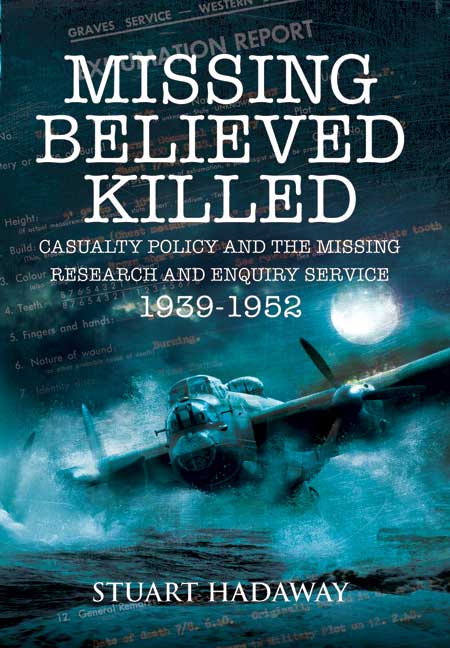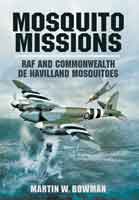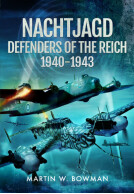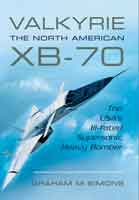Missing Believed Killed (Paperback)
Casualty Policy and the Missing Research and Enquiry Service 1939-1952
Imprint: Pen & Sword Aviation
Pages: 224
ISBN: 9781848846593
Published: 14th March 2012
(click here for international delivery rates)
Order within the next 4 hours, 13 minutes to get your order processed the next working day!
Need a currency converter? Check XE.com for live rates
| Other formats available | Price |
|---|---|
| Missing Believed Killed ePub (5.7 MB) Add to Basket | £6.99 |
During the early years of World War Two it soon became apparent that the system for tracing the whereabouts of the remains of RAF aircrew deemed ‘Missing Believed Killed’ was totally inadequate. The Missing Research Section (MRS) of the Air Ministry was set up in late 1941 to deal with this increasing problem. It collected and collated intelligence reports from a wide variety of official, unofficial and covert sources in an attempt to establish the fate of missing aircrew. Increasingly this included forensic or semi-forensic work to identify personal effects passed on through clandestine channels or bodies washed up on Britain’s shores.
In December 1944 the MRS was expanded and a small team of fourteen men, named the Missing Research and Enquiry Service (MRES), was sent to France to seek the missing men on the ground. With 42,000 men missing, the amount that fourteen men could achieve was naturally limited, so in July and August 1945 a series of meetings at the Air Ministry decided on the rapid expansion of the MRES to over twenty-five times its current size, split between six units with set geographical areas of responsibility.
This book explains why, in their own words, men volunteered for the job, and why they worked for so long at such a gruesome task. Each faced difficulties in terrain and climate, all the way from the Arctic Circle to the jungles of Burma. Local populations, essential to much of the MRES’s work, ranged from the immensely friendly to the openly hostile; teams had to operate in Germany, only recently razed from end to end by the aircrews they were seeking and then also behind an ever solidifying Iron Curtain.
The final chapters explain how to trace RAF members through both personnel and operational records, show where these records are kept and explain how to access them.
This is a very interesting book that goes into different famous aircraft crashes over the years. It covers Amelia Earheart, Amy Johnson, the Duke of Kent, Glenn Miller and a section on the Bristol Beufants. The author has obviously spent a lot of time researching each disappearance and has an extensive knowledge of flight due to being a navigator in the RAF.
GoodReads, Kristin Davison
Read the complete review online here.
This is a captivating story and tells the tale of a group of people who carried out an invaluable service, often in very testing conditions.
History of War Website
While most military personnel were stood down at the end of the Second World War, the Missing Research and Enquiry Service, formed from a small nucleus established in 1941, was expanded and began to trace the remains of those 41,881 RAF aircrew who had been posted as "Missing Believed Killed". With no front line, no definite battlefields and many aircraft lost at night in unknown locations, it was an enormously complex undertaking with investigators having to draw on what little information was available from all manner of sources. Stuart Hadaway first outlines the establishment and development of the MRES throughout the war, and goes on to describe each of the areas where their work took them; from the Arctic Circle to Western Europe, the Mediterranean and Burma. He paints a vivid picture of what they encountered, be it hostile landscapes and climates, uncomfortable forays across the Iron Curtain, or the locals on whose assistance they relied; people who, depending on whether they had regarded the RAF as friend or foe, ranged from the extremely helpful to the decidedly unfriendly. With numerous examples following the progress of specific investigations and the methods used to discover their final resting place, this is a fascinating read which lifts the lid on an aspect of the Second World War which has received little or no prior attention.
Pegasus Archive - Mark Hickman
This is a fascinating book, full of anecdotes. As I mentioned in my introduction, I can't remember the last time I learnt so much from one book about a subject I knew very little about, and a subject that I should know a lot about at that. It certainly adds to my grasp of researching 'missing' airmen, and adds a vital puzzle to understanding their stories.
Daly History Blog
















